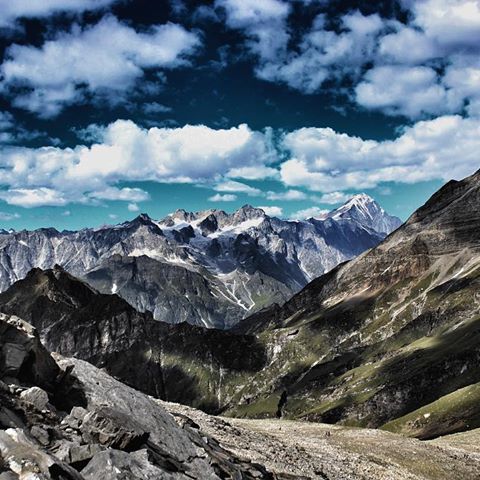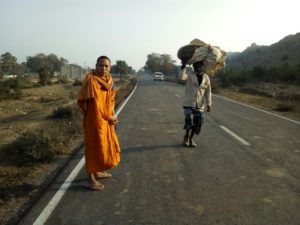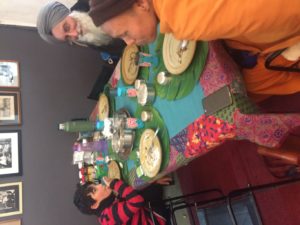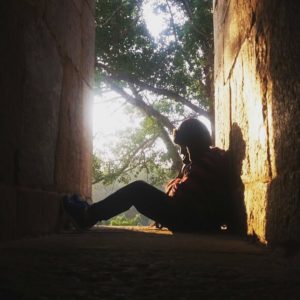Delhi my Underworld
“Once through this ruined city did I pass
I espied a lonely bird on a bough and asked
‘What knowest thou of this wilderness?’
It replied: ‘I can sum it up in two words:
‘Alas, Alas!”
― Khushwant Singh, Delhi

Delhi has risen and fallen many times. The tombs of Emperors stand tenaciously by traffic junctions, slums and shopping complexes. Continuously inhabited since the 6th century BC, Delhi is a city that never dies but reinvents itself, though parts of it look as if they might not last much longer: in the North of Delhi, you might think you had hit the rubbled, exhausted streets of a city at war. The air is so thick your eyes sting. You clutch at your clothing and pull it up to cover your mouth, so pugnacious is the air. But I love Delhi.
Once, an old Sikh warrior called Wazir Singh had brought me through all of Delhi, from the Jama Masijd to the Lodhi Gardens to the Vivekananda Slums, to the Red Fort and to the Zoo, in his black and yellow three wheeler in the heart of an Indian city that held, in its belly, the beautiful and the damned.

Delhi has always been my landing pad in India, yet this time I had landed in Mumbai and our trip to Delhi was an afterthought. The first time I had landed in Indira Ghandi Airport was twenty years ago, with 300 Rupees in my pocket given to me by Lama O, who had sent me to study Tibetan in the Library of Tibetan Works and Archives in Dharmsala. I was led to a white Ambassador taxi (the Indian version of the Morris Oxford, my father told me, and a beautiful anachronism in modern India) and off I sped into the morning light of Delhi, which was a quieter, less smoggy city then…
I saw cows sway their hips in the boom of Delhi traffic, as if Delhi was an open field. Thin men in brown shawls sat on traffic islands, shitting. Children sold marigolds on little wooden trays that hung around their necks. All around me, the marvellous stink of drains. An old woman in a green sari walked slowly through a ditch at the side of the road. I felt guilt for the privilege of being driven in a white Ambassador, modelled on the old 1950s Morris Oxford, sailing through the streets and boulevards of Delhi, my shawl flapping in the wind, the stench of hopeless poverty all around me. In nine hours, I had become a millionaire. My money belt was soaked in sweat. Lost in Shambhala, by Siofra O’Donovan [Read More:https://www.amazon.com/Lost-Shambhala-Siofra-ODonovan-ebook/dp/B00Z83VDD2]
But this time, I arrived in the dark, met by the One, wearing a blue jacket. The journey to my usual haunt in Delhi- Majnu Ka Tila, which has for decades been a settlement for Tibetans, was silent. The One did not talk. We raged through Delhi traffic in the dark, until we reached the North of the City which had grown as silent as we had and sometimes looked as devastated with its abandoned buildings, bodies sprawled under bridges, and some brave souls keeping small, meek fires alive. Shadows passed down the streets. Cows slept, oblivious, as if they were still in the meadow. I saw the light of the golden Sikh temple at Majnu ka Tila and we were dumped at the side of the broken pavement at the gates of the Tibetan colony where we walked down the thin, bockety backstreets under the weary flashing lights of Tibetan restaurants and guest houses, until we arrived where we had first met, two years before at the end of the world in North Delhi.
“I am back in my beloved city. The scene of desolation fills my eyes with tears. At every step my distress and agitation increases. I cannot recognize houses or landmarks I once knew well. Of the former inhabitants, there is no trace. Everywhere there is a terrible emptiness. All at once I find myself in the quarter where I once resided. I recall the life I used to live: meeting friends in the evening, reciting poetry, making love, spending sleepless nights pining for beautiful women and writing verses on their long tresses which held me captive. That was life! What is there left of it? Nothing.”
― Khushwant Singh, Delhi
Not seeing someone is sometimes easier than seeing them when you are grasping at unravelled threads…but we had found three hours that synchronised. Three golden hours that turned to rusty, mottled tin in that Delhi Cab in the Dark. And so we parted, no wiser than we had been when we had frantically tried to find those hours…
But it was Delhi, my Delhi. We hired a heater for our room. My son and I shivered in 11 degrees, having had the last 6 weeks in a glorious average of 33 in South India. We had porridge and Tibetan bread in the morning and a large mug of coffee (me) and set about finding our Tibetan friends and one old, dear friend from Thailand, Pi, who was flying in from Bangkok to meet us. We walked into the cold, narrow little streets and found, miraculously, at our Tibetan stall, our Amala: the mother of the family we had met on the train from Gokarna to Canacona, in the South, some weeks before. We had all promised each other the world, and to meet again. My son had found a brother in her grandson, the little boy Tenzin, in those hours on the train Platform, and in the windy train that brought us all to Goa. And here we found Amala, eating momos at an open restaurant near the Temple. Majnu Ka Tila is her home, though long ago, she came from Mustang, a small Tibetan Buddhist Kingdom in Nepal. We were shivering. We needed shoes, and coats to manage Delhi. She sent us to the Kamla market.

They say that spies are everywhere in Majnu Ka Tila. Chinese spies, that is. And it’s a perfect setting for spies with its warren of streets and dark, dead end corners, mysterious doorways, open butchers, art studios, tailors and bookshops- it is an intensely colourful little passage through Lost Tibet. I’m sure I saw some awkward looking onlookers at the live streaming from the Dalai Lama’s teachings in Bodhgaya, broadcast in the little square in Majnu ka Tila where the two temples are.


In the next few days, torrents of pilgrims were arriving from the Kalachakra Teachings (The Wheel of Time) in Bodhgaya, in the state of Bihar, led by The Dalai Lama. The Kalachakra cycle of teaching is supposed to have originally been brought by the great Buddhist Master Atisha, From Shambhala itself. Shambhala- the hidden paradise in the North, nestled behind the Mountains, the sanctuary for the great Ones who will come when the world is really on its knees. Nothing has ever fascinated me as much as Shambhala. I spent years looking for the truth about it in the Himalayas… hiding in the hinterlands of Tibet on the Indian border. [Read More:https://www.amazon.com/Lost-Shambhala-Siofra-ODonovan-ebook/dp/B00Z83VDD2]

Himalayas by Tej Ram
The crowds from Bodhgaya brought many old friends. While we were elbowing through the crowds in the Tibetan hospital, looking for a cream to smooth my son’s finger from the electric shock he’d gotten from the heater we had hired, we met our old friend, Dr. Bumchung, who had been visiting Ireland long ago, when my son was not yet in the world and we had travelled through the Wicklow mountains with my son’s father, to help Dr. B. Calm down. Cities and streets and urban scapes were not his thing. Dr. B. liked open fields and meadow flowers and only these would sooth him. And here we were, ten years later, in the throngs of the little Tibetan town in Delhi . We spent many hours with Dr. B and his wife in the Tibetan Restaurant, opposite the little cafe where I had been with the One on our first day together, ever.

Pi, our friend the Thai monk whom I had known for 11 years, since my days at Benares, arrived from Bangkok. We floated into Connaught Place from Delhi’s gruelling metro, emerging at Rajiv Chowk, our stop for Connaught Place. Named by the Viceroy during the time of the British Raj, after the first long sojourn in India … Connaught Place (कनॉट प्लेस) is the namesake of our own dear West of Ireland. It was the proud showpiece of Edward Luytens, architect of New Delhi- large and full of circular collonades, labelled ‘Blocks’, in which I have often become hopelessly lost, trudging from one Block to the next, not seeing a great difference between them. This time, however, I did not become lost. I found my old friend Tej in the F Block, sitting in his office as he had been, twenty years before, when we first met and Delhi was a new city to me, which I slowly mastered with the wily little auto rickshaws.

Seeing my friend Tej again, was like coming home. I have always, on almost every visit to Delhi, been at his magazine offices on Connaught place, talking of life, politics, the Hills and visa problems. Now, we had come for lunch on this fleeting visit from which it emerged that T’s wife M had worked in New York with the son of my grandfather’s architectural partner. This heartened me, that the degrees of separation were so diminutive and so delightful. That I had known T for twenty years and had been visiting these wonderful magazine offices for all that time, and I’d never known the extent of things combining. But it was a very random coincidence, and one that I could not have imagined. Because India is my second home, I am always grasping at threads that pull our countries together, despite the gargantuan gaps between them- the friendship of William Butler Yeats and Rabindranath Tagore, or of Eamon De Valera with Mahatma Gandhi. Yet the similarities so often lie, not in culture and politics, but in the very struggle for independence. I usually cannot stop myself informing Indian friends about the stages of suffering the Irish had on the colonial Richter scale, and how this compares to India’s experience with the Raj. I have a compulsion to tell everyone in India about the Great Famine, and how the Irish are not your typical white Europeans, because we came out as battered and divided as they did, after the British left.


d.

Our friend Subs brought us to the Lodhi Gardens, where my son hunted down giant pink candy floss, which brought us full circle from Shirdi, to Delhi. This Candy Floss was his one great delight in India: not the camels, not the temples, not the warm Ocean, but the pink candy floss sold on bikes with rattling bells. Subs drove us from the National Museum to the Secretariat Building on Raisina Hill, New Delhi- two blocks of symmetrical buildings (North Block and South Block) on opposite sides of the great axis of Rajpath, and flanking the Rashtrapati Bhavan (President’s House). Delhi is as grand and stately as it is exhuausted and ruined. Subs and I lamented the degeneration of Haus Kaz, once an enclave of galleries by the beautiful Haus Kaz tomb, now an overcrowded strip of shops and restaurants, full of seething traffic. Still, Subs loves Delhi.
“Delhi. The ruins of an old city, markets, monuments, broken mansions, the zigzag of roads, the still, sad times of music past. And rising up from it, her mother, wind in her hair, laughing like a witch.”
― Debotri Dhar, The Courtesans of Karim Street



On the day we left Delhi, we had Lunch on the F Block again, promising as always to return, and leaving, as we descended the spiral staircase, with small consolation that we would meet the new the Indian Ambassador in Ireland. Nothing consoles me when I must leave India. I always cry. It is my soul’s home. One week later, the city would shake in an earthquake, whose epicentre was in the very place the One had gone to work, in Uttrakhand. If everything topples in this world, I want to be there when it does.



Eloquent and moving. Your observations are amusing and insightful. Something or other is always toppling somewhere in the world, but we certainly do not want you to be there. There are many stories for you to tell, despite your young age, and many dots yet to connect.
Thank you Tejbir. I got a bit overexcited at the end. But I do worry about you all in seismic shifts… it won’t be too long until I am back.
Hi Siofra, really enjoyed the Delhi blog, I see hell and you see heaven, I see despair and you see hope, this must be a Capricorn, me fein, cosmic joke. Glad to hear you had a wonderful time, you were always an intrepid traveller.
Joyce
Thanks, great article.